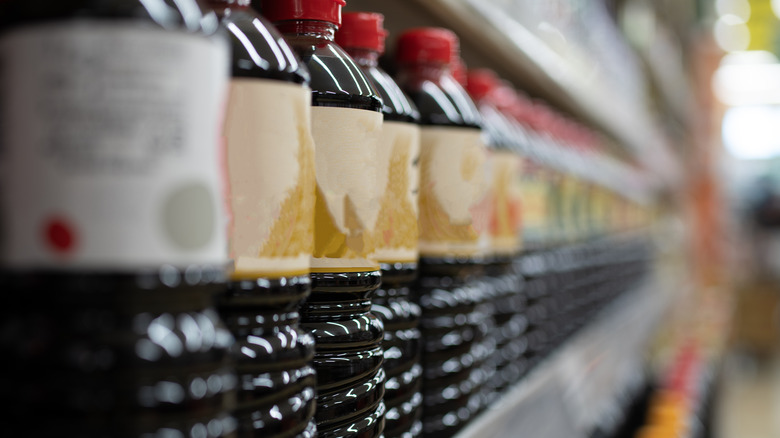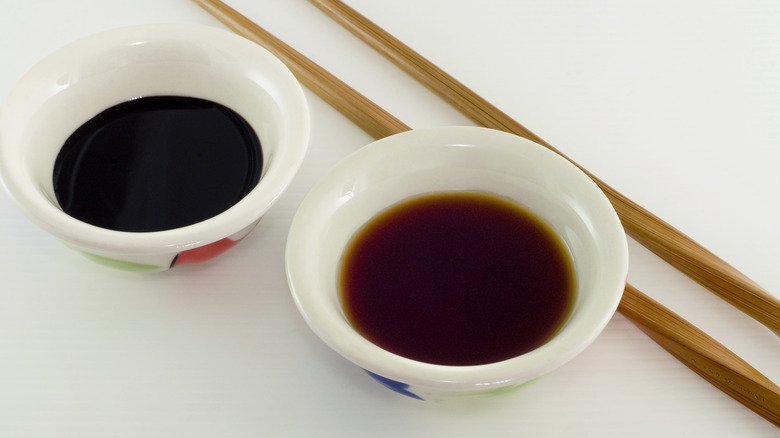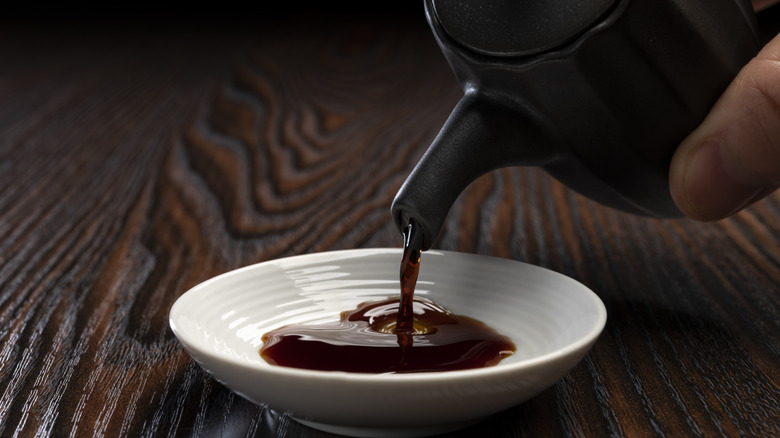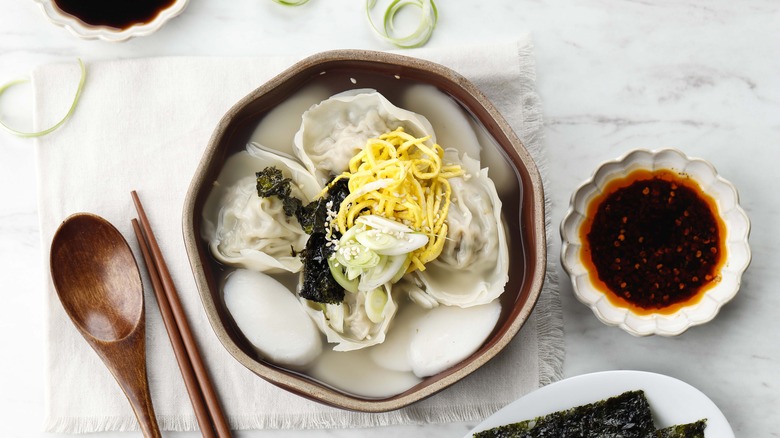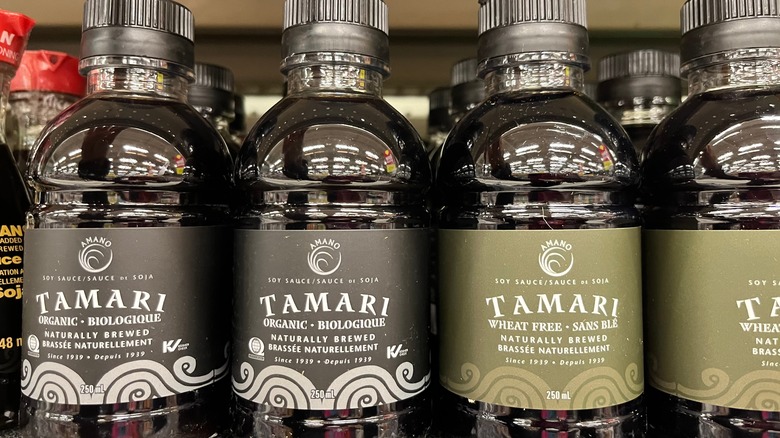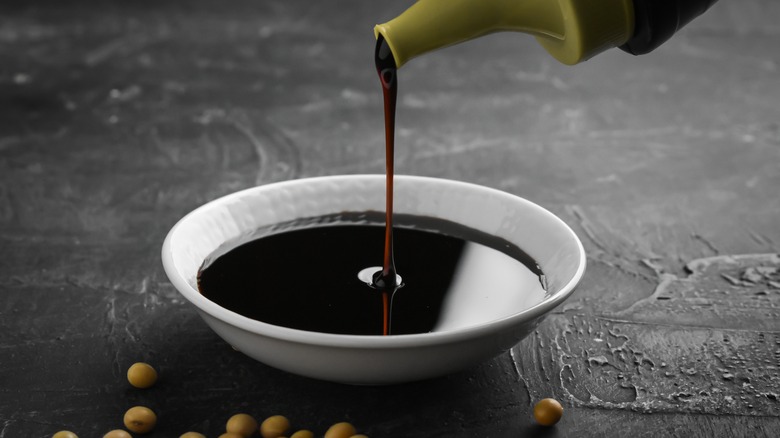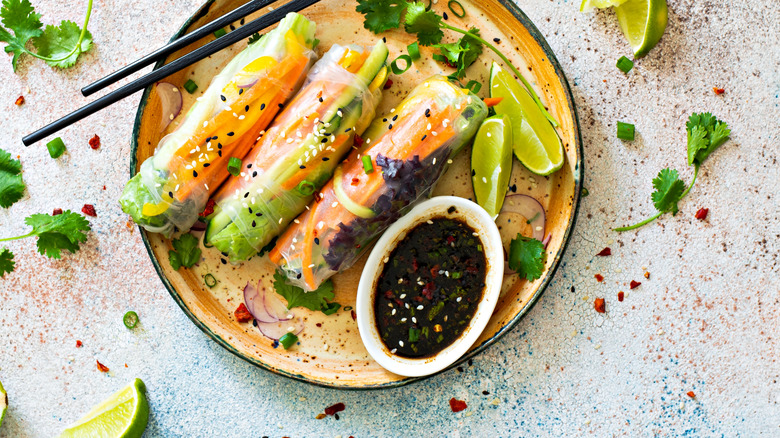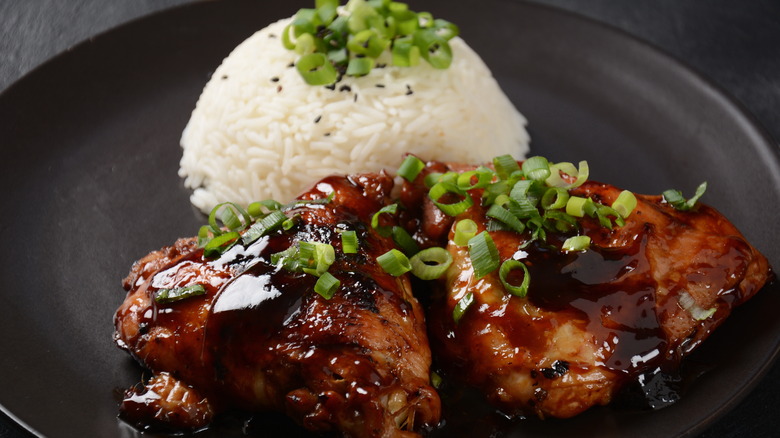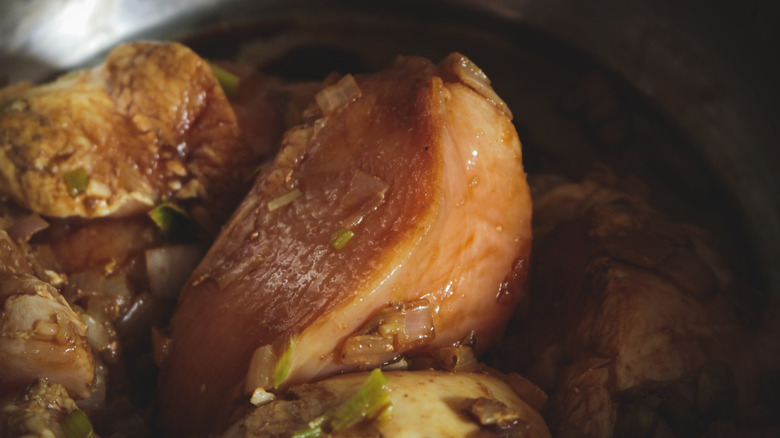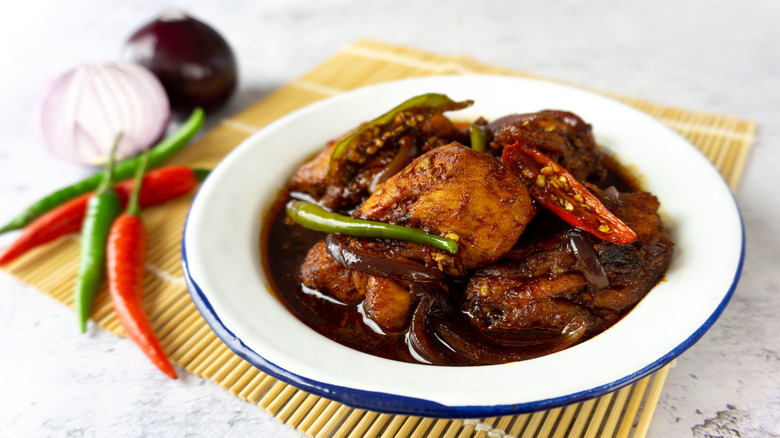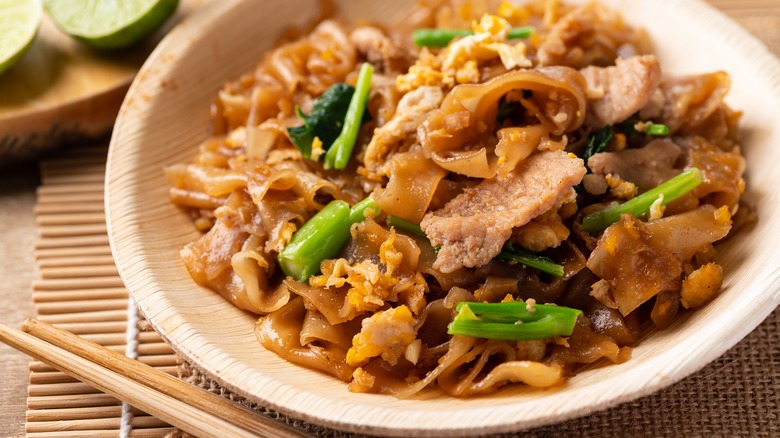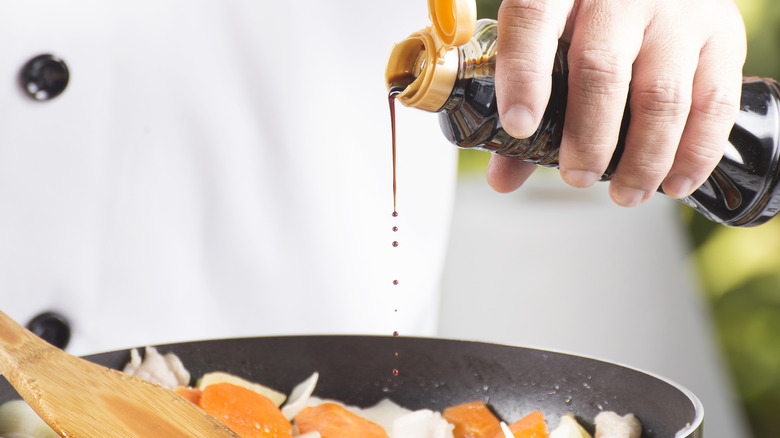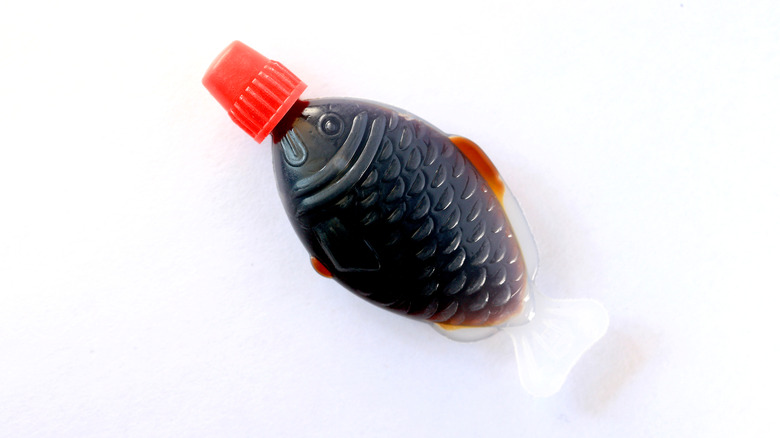The Ultimate Guide To Soy Sauce Varieties
Soy sauce is an essential ingredient in cuisines all across East and Southeast Asia — but to people from elsewhere in the world, the sheer variety may seem a little intimidating. Walk into the right supermarket, and you're likely to find an ocean of bottles with lots of labels and languages. Different types of soy sauce are made in several countries, with subtly different colors, flavors, and uses.
People have been using soy sauce in cooking for thousands of years. The first soy sauce was brewed in China around 500 BCE, where it originally used fermented meat as a main ingredient — meaning that the earliest soy sauce was a lot closer to the fish sauce eaten in Ancient Rome and modern-day Southeast Asia.
Soy sauce is now made from soybeans which are cooked by steaming and then fermenting with crushed, roasted wheat. The whole process takes around six months. The characteristic flavor and slight sweetness of the sauce come from the carbohydrates in the beans, and the salt is added to keep out any harmful bacteria. Soy sauce production is also related to how rice wine is brewed — both use the same type of fungus, koji.
It's the small differences in how the soy sauce is made which make varieties of it have such distinctive tastes. Just as two beers brewed in different places can taste worlds apart, so too can two types of soy sauces.
Dark, light, and white soy sauce
In several countries of East and Southeast Asia, there are two main types of soy sauce. Dark and light soy sauce are noticeably different in color, but also have slightly different culinary uses. Generally, dark soy has a stronger, slightly sweeter taste, and adds more color to dishes it's cooked with too. In cooking, it should be treated with a little more care, as too much can easily become overpowering. Some chefs advise not to use dark soy unless the recipe specifically calls for it. Light soy sauce, on the other hand, is much milder and can usually be treated as a kind of general-purpose soy sauce, both in cooking and as a table condiment.
The third most common type of soy sauce which you might encounter is white soy sauce. With a color more golden than white, this is mainly found in China and Japan. The difference comes from the fact that it's made with far fewer soybeans and more wheat, with the wheat being steamed and the soybeans roasted — the opposite of the usual brewing process. It has a far milder taste than regular soy sauce, sweeter and more subtle, with a flavor that some people compare to rice wine. Where some dishes need the rich, caramel-like flavor imparted by the darker soy sauces, others benefit from the lighter taste of white soy, and it can also be used for dipping.
Chinese jianyou
China is the original home of soy sauce, and it's an essential part of Chinese cuisine, used with all kinds of food from fried rice to dumplings. Chinese soy sauce has a particular taste too, which anyone familiar with soy sauce can recognize. It has a distinctive deep, rich flavor compared to most other varieties. The Chinese name for it is jianyou, but this name is seldom used in English; confusingly, it's usually just known as "soy sauce" in the anglophone world. This means that, in English-speaking countries, many people assume that most soy sauce is Chinese unless told otherwise.
Chinese soy sauce can be thought of in a very similar way to Italian balsamic vinegar. While it's all essentially the same stuff, you really do get what you pay for, and the finest soy sauce will usually have an appropriately higher price tag attached. The best is organically produced and traditionally brewed, while the cheapest versions are factory-made with faster chemical methods.
As well as dark, light, and white, a few other varieties are enjoyed in China. Mushroom-flavored soy has added richness and umami, double black soy contains dark molasses, and some versions have added seasonings intended to go with specific dishes like seafood. If in doubt, light soy sauce is the most commonly used type in Chinese cuisine.
Japanese shoyu
Shoyu is Japan's most widely eaten condiment. Whether you're at a busy Tokyo sushi bar or enjoying home cooking in Hokkaido, there's likely to be a bottle of shoyu on the table, and a small dish of it to dip food into. Several other common sauces in Japan, with their own specific uses, have shoyu as a main ingredient. Tsuyu is one example, made with shoyu and seafood stock, and is served with noodles like soba, or with tempura. Another is ponzu, made with shoyu and citrus fruit juice and is used as a dipping sauce with hotpot dishes.
Like with Chinese jianyou, shoyu comes in different varieties, but the type you're most likely to find in Japan is dark shoyu. Unlike in Chinese cooking, light shoyu is a lot less common. White shoyu also exists, but it isn't often used as a condiment. In Western Japan, another version is saishikomi shoyu, also known as refermented soy sauce for its unusual brewing method. This version is sweeter and more strongly aromatic than regular shoyu, and is mostly used as a table condiment. If in doubt, the bottles of shoyu you're most likely to find on sale, both in Japan and elsewhere in the world, are probably dark shoyu. It's also one of the most widely available kinds of soy sauce; the world's largest soy sauce manufacturer is the Japanese Kikkoman Corporation.
Korean ganjang
Korea has a few varieties of soy sauce, known as ganjang. The traditional kind is guk-ganjang, better known as "soup soy sauce," which is made in a traditional Korean way. It's lighter in color but salty and strong tasting, able to flavor a whole pot of soup (like jjambbong or tteokguk) without significantly darkening the broth, hence the name.
A common version of soy sauce in modern Korea is whe-ganjang, which is relatively new. It's made in a completely different way, being much more like Japanese shoyu — the "whe" in the name means Japanese. This soy sauce has a darker color but milder flavor than guk-ganjang. Other varieties of ganjang include yangjo-ganjang, naturally brewed soy sauce; jin-ganjang, a blend of naturally brewed and some other variety of soy sauce, and; mat-ganjang, which is flavored soy sauce, and can contain other ingredients like mushroom, onion, or apple.
Cheaper Korean soy sauces are honhap-ganjang and sanbunhae-ganjang, which are factory-made using chemical methods. These are much poorer quality and usually have additives to improve the flavor. Unless you're on a shoestring budget, they're best avoided. If in doubt, yangjo-ganjang is the best general-purpose kind of Korean soy sauce.
Japanese tamari
Tamari is technically not a soy sauce at all, but it can be used like one. Another vital ingredient in Japanese food is miso, also made with fermented soybeans, and traditionally, tamari is a byproduct of miso production. It's darker and richer than other soy sauces, but it's also less salty and with a more balanced flavor. This makes it an excellent choice as a dipping sauce.
Nutritionally, tamari is a lot like shoyu and is similarly high in sodium, but it's also less likely to contain additives. The most attractive thing about tamari though, is that it's suitable for people with gluten intolerances. Most soy sauce includes wheat in the production process, but traditionally made tamari does not contain any grains. It's wise to check the labels, just to be certain, but tamari should be gluten-free, making it a good alternative to regular soy sauce for anyone with celiac disease.
Indonesian kecap
Indonesian soy sauce is known as kecap. If the name sounds familiar, it's because it has the same origin as the word ketchup; both words derive from the Chinese word koechiap, which simply means sauce. There are a few different types of kecap in Indonesia. Kecap hitam is dark soy sauce, kecap asin is general-purpose soy sauce, and kecap ikan is fish sauce. The version Indonesia is best known for, though, is kecap manis.
Kecap manis is thick, sweet, and syrupy. Far sweeter than most other types of soy sauce, it adds a characteristic flavor to Indonesian cuisine and has the distinction of being Indonesia's favorite condiment. Kecap manis is made from dark soy sauce, and the sweetness comes from palm sugar which also adds an unmistakable flavor of its own. It also has a few spices added, making a versatile sauce that can be added to a wide variety of different foods. The word "manis" translates as sweet, so kecap manis is sometimes known as "sweet soy sauce" but it stands out as being a bit more than just another type of soy sauce.
Vietnamese tương
Soy sauce in Vietnam is known as tương or xì dầu, and the most popular type is light soy sauce. Vietnamese tương, however, has a distinctly different taste to its counterparts in other nearby countries. It's typically both lighter and thicker than Chinese light soy sauce, with a slightly sour taste, better complementing the gentle but complex flavors of Vietnamese cuisine. Vietnamese cooking also uses dark soy sauce, but its stronger flavor makes it less popular. The main reason to use dark soy sauce in Vietnamese cuisine is to add color to dishes.
Vietnamese soy sauce is also made differently to the soy sauces of other countries. Where Chinese soy sauce is made with wheat, one traditional Vietnamese type of soy sauce is made with glutinous rice instead, giving it a noticeably different taste. Visitors to Vietnam should be aware that most modern soy sauce is made with wheat, and so contains gluten.
Philippine toyo
In the Philippines, the local version of soy sauce is known as toyo. Like with the soy sauces of other countries, it has its own distinctive style, and it's an essential ingredient in adobo, a classic Filipino dish. The cuisine of the Philippines is full of robust flavours, rich and wholesome with a variety of spices, showing influences from East Asia, Southeast Asia, and colonial influences from Spain. Toyo, fittingly enough, is a more potent soy sauce than many of those from other countries, suiting the bold flavors of Filipino cooking. It has a thinner consistency than most Southeast Asian soy sauces, but tends to be a lot saltier than other varieties too.
In Filipino food, while it's frequently used in cooking and dips, it's often added to marinades too. As a table condiment, it's usually added to foods like fried rice in place of adding salt, and some people will even make a simple meal from just a bowl of steamed rice and a couple of dashes of toyo.
Peruvian sillao
Peruvian cuisine has some strong East Asian influences, and Chinese restaurants known as chifas are found all over Peru. Sillao is Peru's homegrown version of soy sauce, brewed and enjoyed locally. Fried rice, known as arroz chaufa, is a favorite food in Peru. It's often made at home as a way of using up leftover foods, but it's popularly found on restaurant menus too. Sillao is an essential seasoning for the dish, often together with aji amarillo, a spicy yellow Peruvian pepper and another distinctive part of Peruvian cuisine.
Sillao is similar to Chinese soy sauce, but it has a slightly tangier, saltier flavor. As well as a seasoning, it's used in marinades for foods like pollo al sillao, together with garlic and lime juice. Another chicken dish, pollo a la brasa, involves marinading whole chickens in a similar way, before grilling them over a wood fire to give a smokey barbecue flavor.
Malay kicap
Malay soy sauce is known as kicap, and it's unusual to find a kitchen in Malaysia without a bottle of it. Like Filipino toyo, Malay kicap is mostly used in cooking and as a condiment, but it's often used in marinades too. Malay soy sauce is most commonly light soy, and it's essential in a lot of Malay dishes. Dark soy sauce is often used though, and Malay dark soy often has a little added molasses for a deeper color and a hint of sweetness. Sweet soy sauce is also popular in Malaysia, very similar to the kecap manis popular across Indonesia.
Numerous homemade comfort foods in Malaysia are made with kicap. One example is telur masak kicap, a quick and easy dish of eggs, spring onions, and chili peppers, fried with soy sauce. Another is ayam masak kicap, a hearty marinaded chicken dish with a name that literally means "chicken cooked in soy sauce."
Thai sii-íu
Thai soy sauce is variously transliterated as either sii-íu or see ew, and it's often used in Thai stir-fries. One example is pad see ew, a dish quite similar to Thailand's signature dish, pad thai, but with a denser, heavier flavor. Soy sauce in Thailand comes in both dark and light varieties. It has a flavor which is milder and less salty than Chinese or Japanese soy sauce, partly thanks to being balanced with a little extra sweetness. Balancing flavors is an essential principle in Thai cuisine, so it only makes sense that the same idea is used in making condiments too.
Thai dark soy sauce gets its sweetness from palm sugar, adding a distinctive flavor, and Thai sweet soy sauce is made in a very similar way but with much more sugar added. Thai light soy sauce comes in two varieties, one plain and one flavored with mushrooms. Light soy sauce in Thailand can be confusingly named though. It's sometimes referred to as "thin soy sauce" and sometimes called "white soy sauce" — but it should be noted that this is not the same as the white soy sauce found in East Asian cuisine, which is not usually found in Thai kitchens.
Hawaiian shoyu
Modern Hawaii has some strong cultural influences from East Asia, particularly Japan — so much so that there are streets in Honolulu with restaurant signs written in Japanese. The Japanese influence on Hawaiian cuisine means that most Hawaiian homes keep a bottle of shoyu in the kitchen. Hawaiian shoyu is a lot like the Japanese shoyu which inspired it, and is brewed locally in Hawaii. Most Hawaiian shoyu is made by the Aloha Shoyu Company, which makes several varieties based on those used in Japanese cuisine, including tamari. It's also typically less salty than Japanese shoyu brands.
A lot of Hawaiian cuisine includes fusion cooking with both Western and traditionally Hawaiian dishes. One example is shoyu hot dogs, made from regular hot dogs sliced and braised with shoyu and ginger. Meanwhile, poké is a beloved traditional Hawaiian dish, and the version often enjoyed today in poké bowls includes a dash of shoyu as seasoning.
Chemical soy sauce
In the additive-conscious modern world, the name of this may feel rather uncomfortable, but the unpopularity of chemical soy sauce is mostly because it has an inferior flavor to the traditionally brewed variety. Chemical soy sauce was invented to make soy sauce production cheaper and faster than traditional fermentation. It uses soybeans cooked at high temperatures and treated with strong acid. This breaks up the proteins in the soybeans, speeding up the fermentation process dramatically.
The upside is that this kind of soy sauce can be created in just a few days rather than several months. The downside is that it has a bland, shallow taste because the flavors which usually develop slowly during fermentation are absent. As a result, chemically produced soy sauces tend to also include additives – caramel and corn syrup — to improve the color and taste.
It's noteworthy that many people don't consider chemical soy sauce to be soy sauce at all. In Japan, it's illegal to sell it as soy sauce — although it may sometimes be blended with true soy sauce to reduce costs. This is the kind of soy sauce you might find in plastic packets with cheap takeout sushi. Unless your budget is tight, it's best to avoid the cheapest bottles of soy sauce, to ensure that anything you buy is properly brewed and fermented.
